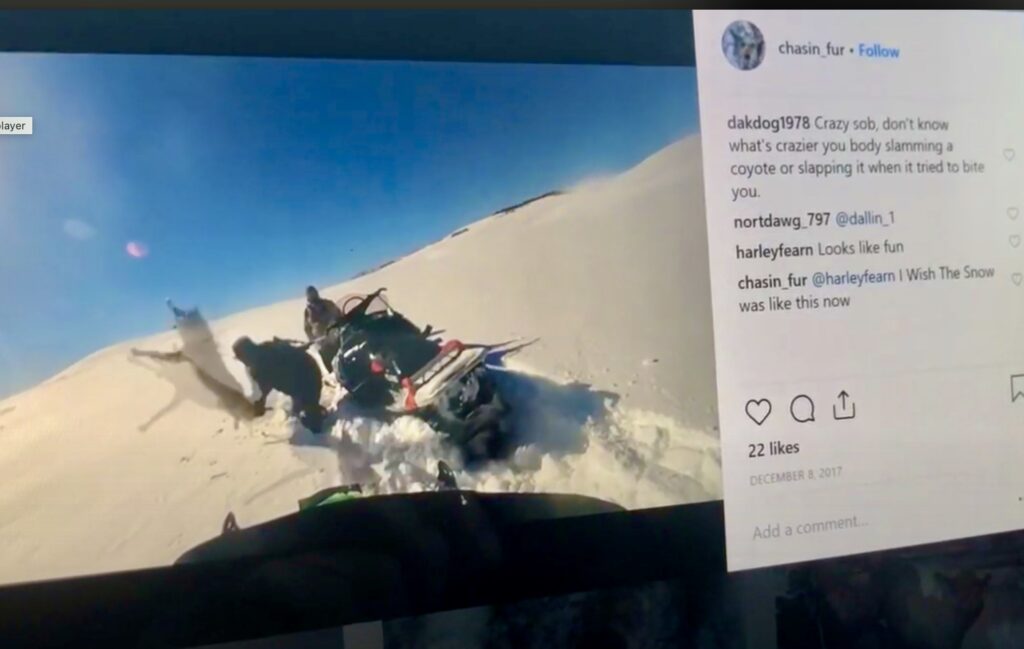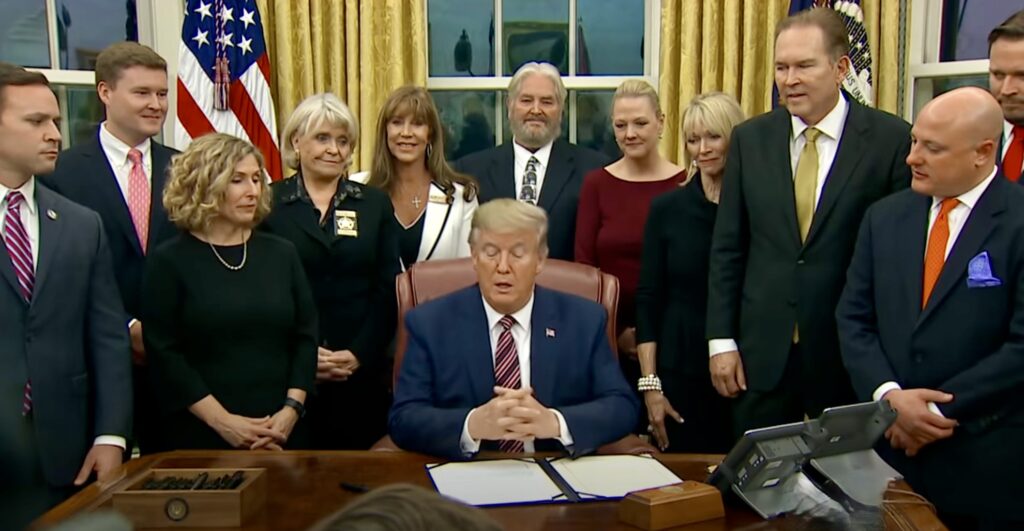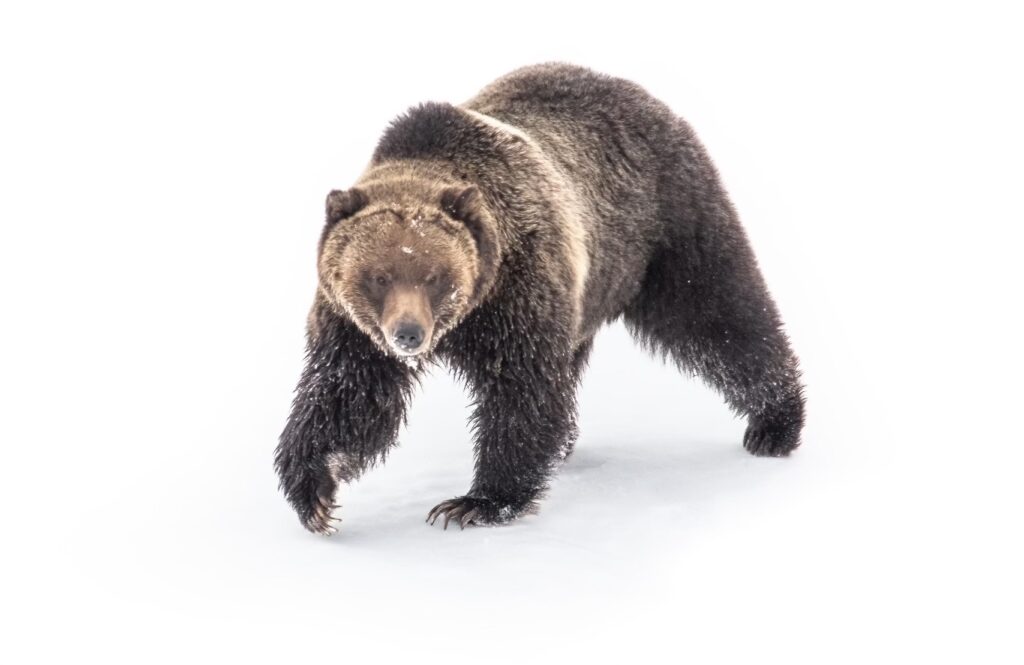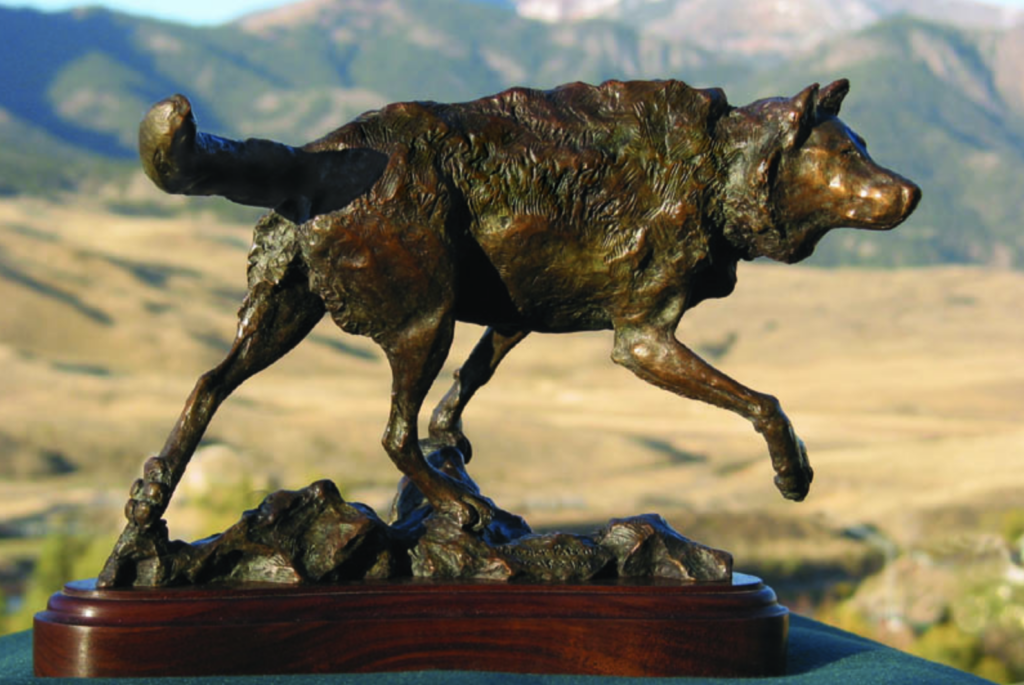By Todd Wilkinson
Donald Trump Jr. is a self-described traditional conservationist well known for being a big game hunter. He has traveled to remote corners of the globe to fill his hunting tags. He credits his younger years spent in Colorado with firing his passion and identify as an outdoorsman.
The former President’s son and namesake has also joined current Montana Gov. Greg Gianforte on prairie dog shoots in the Treasure State where the native rodents are used for target practice as a way of lethally controlling their numbers. Ranchers and farmers portray prairie dogs as scourges—competitors to cattle and sheep for bites of grass, and even as hazards, claiming their underground burrows pose safety risks to cows and horses that might step into holes and break their legs. (That assertion has been largely debunked).
On internet sites where homemade and professional-grade videos are shared for viewing, there are countless examples of digital content showing rifle shooters, some with automatic weapons, gathered at the edge of prairie dog colonies taking aim. The phenomenon of a bullet striking a prairie dog and causing its small body to be blown apart has been described by some participants, using the parlance of the medium, as creating “red mist.”
“We have a responsibility to honor the dignity of God’s creation. With today’s act, we take the critical step toward being more responsible and humane stewards of our planet and all who we want to cherish and take care of, and all of those who live on it.”
—President Donald J. Trump in signing the Preventing Animal Cruelty and Torture Act in 2019
This is not a story, however, about the well-established ecological importance of prairie dogs as a keystone species, or as beneficial habitat creators for more than 130 different animals, or as an important food source for predators and scavengers, including the critically-imperiled black-footed ferret. Nor is this a critique of those who shoot prairie dogs for fun, using the same arguments that people do when they kill coyotes and wolves. Often, the latter tell themselves they are serving a larger good in helping ranchers and hunters protect livestock and big game animals.
Instead, consider it a prelude to the question of whether federal animal cruelty laws now exist that might prohibit the kind of incident in Wyoming which has caused an international uproar. In Sublette County in the southern half of the Greater Yellowstone Ecosystem, a 42-year old man is alleged to have run down a young wolf with a snowmobile, captured the injured wild canid, wrapped its muzzle with duct tape, brought it to a saloon live to show his friends and then killed it. The man, Cody Roberts, was given a $250 fine based on a somewhat obtuse code which pertains to illegally possessing a warm blooded animal.
To date, Mr. Roberts has not faced any serious animal cruelty charges at the local, state or federal level. Wyoming officials say that because wolves and coyotes are classified as “predators” in the area where the Roberts incident occurred, they are not subject to regulations governing cruelty and wanton destruction normally afforded to big game species, livestock, horses, and pets. It remains legal for people to chase down wolves and coyotes to their deaths with snowmobiles in the vast majority of Wyoming. Coyotes also can be pursued by snowmobilers in Montana and Idaho.
Six years ago this journalist wrote an investigative report about other lethal incidents that involved different Sublette County residents running over coyotes with snowmobiles. In those cases, the participants filmed themselves in action and then posted the videos onto social media. Copies were made and law enforcement officials I contacted told me to hang onto them in the event they were ever needed as evidence.
In one of the videos, a coyote is run over and flattened by a snowmobile in southwest Wyoming. The driver gets off his sled, picks up the stunned coyote by its back legs and slams the traumatized animal into the snow. He hopes to stun it, but instead it attempts to bite the human antagonist who slaps it across its face before the animal runs for its life away. The driver curses and then two snowmobiles give chase, catching up with the coyote and running it over again at high speed. At the point, the video ends.
The footage was apparently made and shared by a person on social media with the handle “chasin’_fur” along with a profile photo featuring a coyote that was crushed in the snow, apparently dead, and its open eyes peering skyward. One of the commentators writes: “Crazy sob, don’t know what’s crazier you body slamming a coyote or you slapping it when it tried to bite you.”



Despite the recent characterizations made by Wyoming Gov. Mark Gordon and Brian Nesvik, director of the Wyoming Fish and Game Department, that the 2024 Roberts incident was a rare singular one-off event, these videos prove otherwise. Combined with banter on hunting chat sites and interviews I did with Sublette County residents who said chasing down wolves and coyotes with snowmobiles was a well-known form of winter entertainment—a form of “hunting” known to occur by local game wardens—those arguments do not hold up. And even if they did, why has there been such resistance in Wyoming to passing laws that send a symbolic message making it clear animal torture is not tolerated?
“The facts belie state officials’ claims that running over wildlife with snowmobiles and further torturing them doesn’t exemplify Wyoming values,” asserted Amaroq Weiss, senior wolf advocate with the Center for Biological Diversity in a statement released April 23. “By allowing wolves and other predators to be killed by any and all means in most of the state, Wyoming has created an outdoors torture chamber for wildlife. I hope the federal agencies step up to ban this atrocious practice on the lands they manage in Wyoming and across the country.”
Similar discussions to those occurring today, pertaining to the absence of applicable animal cruelty statutes, also happened then. In Wyoming, in 2019, a legislator from Jackson Hole, Mike Yin, introduced a bill that would have outlawed the use of snowmobiles in harming or killing wolves and coyotes but it never got public airing because of opposition from the livestock and hunting industries.
But because the incidents highlighted in the 2018 story were chronicled on video and those videos were shared on social media platforms across state lines and international boundaries, attorneys for several animal rights organizations wondered if that could be a hook for prosecution. Such speculation, it turned out, were fueled by actions taken by then President Donald J. Trump who expressed open disdain for animal cruelty.
On November 25, 2019 at The White House, Trump signed into law H.R. 724, a bill called The Preventing Animal Cruelty and Torture (PACT) Act. He was surrounded by a number of American animal rights advocates who successfully marshaled support for the bill in both houses of Congress after six years of lobbying. Flanking the President was Pam Bondi, who had served as attorney general of Florida and was an aggressive enforcer of animal cruelty laws in that state. Also supporting enaction of PACT was Lara Trump, the President’s daughter in law who previously was a television producer and who today is co-chair of the Republican National Committee.
After President Trump signed the bill, he said, “This commonsense legislation restricts the creation and distribution of videos or images of animal torture. It is important that we combat these heinous and sadistic acts of cruelty, which are totally unacceptable in a civilized society.”
He added, “We have a responsibility to honor the dignity of God’s creation. With today’s act, we take the critical step toward being more responsible and humane stewards of our planet and all who we want to cherish and take care of, and all of those who live on it.”
The PACT ACT was catalyzed by the proliferation of imagery deemed disturbing and it sprung from an earlier context.
For years, and prior to the internet, there were many urban legends (unsubstantiated stories often concocted by conspiracy theorists) related to this claim: that murders of humans were being committed for commercial entertainment purposes. Homicides were allegedly captured on film and the videos sold via underground black-market dealers. Some were allegedly part of the pornography industry. Called “snuff films,” the rumors of their existence created a public outcry but subsequent investigations found such stories to have little basis in fact.
There has been, however, a non-human parallel to snuff films, and the videos being made are numerous and real. Their ability to reach millions started with the advent of channels like YouTube founded in 2005. In some of them, kill shots of an animal are memorialized as the climax to successful hunts or other outings when animals are shot. The form of media is known as animal “crushing.” Coincidentally, the Pact Act, which made their distribution a felony, was passed months after the coyote-killing incidents were described in my 2018 story.
Did those videos, which showed the subjects chasing down coyotes and then beating the animals to death, qualify? Today, it’s an open debate that revolves around the classification that a state like Wyoming bestows upon species like wolves and coyotes.

Animal crushing is defined by legal experts this way: “The term ‘animal crushing’ means actual conduct in which one or more living non-human mammals, birds, reptiles, or amphibians is purposely crushed, burned, drowned, suffocated, impaled, or otherwise subjected to seriously bodily injury…”
Were the actions above carried out by a person against a big game species in Wyoming, most likely they would qualify as wanton destruction of public wildlife and they were be subject, depending on the severity to a steep fine, potential jail time, loss of hunting privileges and the negative social stigma that comes with those caught committing poaching offenses. Indeed, had wolves been run down with snowmobiles in the 15 percent of the state where they are classified as trophy game animals, tough penalties, including animal cruelty charges might have applied.
That is not the case in 85 percent of Wyoming where the “predator” classification of wolves allows for unlimited killing by almost any means. Statewide, except in national parks, it’s open season on coyotes.
“Wyoming has deliberately created differing classifications for wolves to enable the state to dance around standards of decency related to how public wildlife should be treated,” says Brooks Fahy, founder of the advocacy group Predator Defense, one of the leaders in getting the use of ultra-toxic M-44 “cyanide bombs” outlawed that had been used for decades by government agents to eradicate coyotes on federal lands.
“You could argue that what happened with the Roberts’ wolf incident fits the very definition of the kind of egregious human behavior described as ‘crushing’ but by design it has cleverly-conceived categorical exclusions,” Fahy said.
The PACT Act amended federal criminal code to prohibit intentionally engaging in animal crushing in or affecting interstate or foreign commerce or within the special maritime and territorial jurisdiction of the United States. An earlier version of the law prohibited knowingly creating or distributing an animal crush video. So far as anyone knows, Roberts did not make a video of his alleged exploits.
And just as in his case, with Wyoming asserting he can’t be prosecuted because animal cruelty laws do not apply to animals categorized as “predators,” the PACT Act also created a caveat in order to win passage. The amendment signed by Trump “added exceptions for conduct that is for predator or pest control, medical or scientific research, or necessary to protect the life or property of a person from a serious threat caused by an animal.”
“The killing of Cecil the Lion in Zimbabwe in 2015 ignited a level of public outrage that I had rarely seen in my four decades of doing wildlife conservation work. I think the Roberts incident has the potential to do the same. There is no place for this kind of Medieval behavior in a country that calls itself civilized. It’s indefensible and the longer that states like Wyoming refuse to take brazen acts of animal cruelty seriously and pass laws to prevent them, the more they tarnish their reputation in the world.”
Brooks Fahy, founder of Predator Defense
Wayne Pacelle is well versed with what the Pact Act says and notes that getting it through both houses of Congress required negotiation with hunting groups. Circulation of hunting show videos on social media that show animals being shot, and are produced replete with commercial sponsors, has become a big business.
Pacelle is president of the group Animal Wellness Action and the Center for a Humane Economy.
“The federal PACT Act exempts hunting, a measure I initiated, but I do think a common sense definition of ‘hunting’ excludes ‘attacking an animal with a vehicle,’” he said in an interview. “A prosecutor would have to make a case that snowmobile use bears no resemblance to hunting.”
Is running down wolves and coyotes a form of hunting or is it not? A new pro-hunting group called HOWL For Wildlife did not mince words. “We are shocked and outraged at the recent cruel behavior involving a live wolf in Daniel, Wyoming, that has recently come to light. There is no justification for the treatment of any wild animal in this manner. The choice to intentionally extend the suffering of an animal for any reason is antithetical to sportsmanship; it indicates a lack of character, demonstrates deranged, antisocial behavior, and has no place in a system of hunting, trapping, and wildlife conservation,” the organization wrote in a statement, and added:
“We unequivocally and without hesitation condemn these actions. To help prevent actions like this in the future, we call upon the state of Wyoming to statutorily implement and direct the Department of Agriculture to define a legal (ethical) means of take within the predator zone of Wyoming.”
To avoid ambiguity about this kind of conduct in the future, Pacelle said “a new federal law is needed that bans the intentional running down and crushing wildlife on federal lands.” In the meantime, he argues that Wyoming lawmakers “ought to pass a state version of that ban post haste.”
“Existing Wyoming law is merciless when it comes to the treatment of wolves, but when Cody Roberts took the wolf into possession and tormented her, he violated the state anti-cruelty law,” Pacelle says. He added, if the wolf was run over on federal land, “Roberts may be vulnerable and subject to a Lacey Act violation for possessing the wolf and driving the wounded animal in his car.”
On Monday, April 22, Predator Defense called for a tourist boycott of Wyoming, modeled after a successful boycott campaign that targeted Alaska decades ago after the state refused to halt its aerial gunning of wolves. Among the supporters of the boycott was the late renowned nature writer Barry Lopez, who authored the book Of Wolves and Men. In addition, Predator Defense is among a growing coalition of wildlife organizations seeking to have wolves placed back under federal protection in the Northern Rockies.
Some 60 groups also are seeking to have the Department of Agriculture and Department of Interior, which have jurisdiction over 193 million acres of national forests and 245 million acres of BLM lands, adopt rulemaking that would criminalize cruelty, torture and inhumane treatment of animals on those public lands. Part of their push, too, is to get controversial “wildlife killing derbies” banned from federal public lands in which contestants are awarded prizes for shooting the most wolves, coyotes and other species.
Groups suing the US Fish and Wildlife Service to have wolves re-listed include Western Watersheds Project, International Wildlife Coexistence Network, WildEarth Guardians, Nimiipuu Protecting the Environment, Alliance for the Wild Rockies, Friends of the Clearwater, Wilderness Watch, Trap Free Montana, Protect the Wolves, and Predator Defense. They argue that the Roberts incident in Wyoming, which exposes the state’s inability to professionally manage wolves ethically and humanely statewide, is one reason. Another is that the states of Wyoming, Montana and Idaho have adopted politically-driven policies, they claim, that sanction an aggressive reduction of wolf numbers. This not only violates the goal of biological recovery but it also, in effect, openly promotes the re-annihilation of the species.
“The killing of Cecil the Lion in Zimbabwe in 2015 ignited a level of public outrage that I had rarely seen in my four decades of doing wildlife conservation work,” Fahy said. “I think the Roberts incident has the potential to do the same. There is no place for this kind of Medieval behavior in a country that calls itself civilized. It’s indefensible and the longer that states like Wyoming refuse to take brazen acts of animal cruelty seriously and pass laws to prevent them, the more they tarnish their reputation in the world.”
Animal cruelty is symptomatic, experts say, of a larger problem. At The White House signing ceremony for PACT in 2019, Sheriff Carolyn “Bunny” Welsh of Chester County, Pennsylvania said, “On behalf of law enforcement, this is another effort on your part and success on your part to assist federal, state, and local agencies to work together, because animal cruelty — the cruelty of animals, the destruction in the home, domestic violence — everything is related. And what this does is enable law enforcement to work together on the federal, state, and local level to investigate and prosecute animal cruelty.”
ENDNOTE: For more on the Wyoming wolf-killing incident, click here. Also below is a glimpse of Wyoming code which creates a double standard in the state’s approach to professional wildlife management and regulations forbidding the pursuit of big game animals with machines; it includes using those machines as potentially lethal weapons. While wolves are covered by the regulations below in 15 percent of the state, where they are a “trophy game animal,” in the rest of Wyoming, where they are categorized as predator, the provisions do not apply.

Subscribe
Never miss a story, subscribe to our newsletter!





